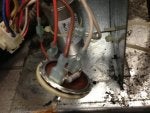Hello Everyone!
I'm working on a Global Refrigeration 3-Door reach-in freezer with glass doors.
Model is ULG80BCP-6
Compressor is a KATB-015E-CAV-234 (404A).
Original Run Capacitor was 130-156 330VAC (copeland).
Replaced with a BMI MARS 124-156 330VAC (local part).
A few weeks ago I got a call for this unit (customer says "not working - making lots of noise). I found the run capacitor blew the top off of it. The whole unit would shake violently trying to run. I also found the service valves leaking, unit low on charge, and has bad discharge valve plate (high side leaks back). Replaced run capacitor with local supply part and replaced valve plate assembly and service valves, evacuated unit below 500 microns (around 250-300 microns believe) and weighed in new refrigerant R404A to factory specs. Unit was working great. Got a call back and I came back today to hear compressor short cycling off compressor safety. Unit pulls about 15-16 amps constant until trips off. Start capacitor tested fine at 25uF. Run capacitor was extremely hot and did not read anything at first, started to cool down and measure 260uF (rated 124-156uF). I confirmed the capacitors ratings are correct from Emerson website so doesn't look like someone before me installed wrong capacitor (hopefully I didn't!). Unit still has refrigerant, compressor pulls a vacuum when suction service valve is front seated, no leak back from discharge side. When unit runs (5 seconds), discharge pressure doesn't get above 215psig. I know I need to replace run capacitor again but i'm not sure what else is going on with this unit. Any help would be greatly appreciated! This manufacturer is horrible, still waiting on tech support to call me back on another repair for 3 weeks.
JC
(
![]()
I'm working on a Global Refrigeration 3-Door reach-in freezer with glass doors.
Model is ULG80BCP-6
Compressor is a KATB-015E-CAV-234 (404A).
Original Run Capacitor was 130-156 330VAC (copeland).
Replaced with a BMI MARS 124-156 330VAC (local part).
A few weeks ago I got a call for this unit (customer says "not working - making lots of noise). I found the run capacitor blew the top off of it. The whole unit would shake violently trying to run. I also found the service valves leaking, unit low on charge, and has bad discharge valve plate (high side leaks back). Replaced run capacitor with local supply part and replaced valve plate assembly and service valves, evacuated unit below 500 microns (around 250-300 microns believe) and weighed in new refrigerant R404A to factory specs. Unit was working great. Got a call back and I came back today to hear compressor short cycling off compressor safety. Unit pulls about 15-16 amps constant until trips off. Start capacitor tested fine at 25uF. Run capacitor was extremely hot and did not read anything at first, started to cool down and measure 260uF (rated 124-156uF). I confirmed the capacitors ratings are correct from Emerson website so doesn't look like someone before me installed wrong capacitor (hopefully I didn't!). Unit still has refrigerant, compressor pulls a vacuum when suction service valve is front seated, no leak back from discharge side. When unit runs (5 seconds), discharge pressure doesn't get above 215psig. I know I need to replace run capacitor again but i'm not sure what else is going on with this unit. Any help would be greatly appreciated! This manufacturer is horrible, still waiting on tech support to call me back on another repair for 3 weeks.
JC
(





